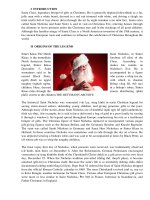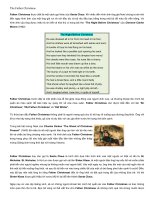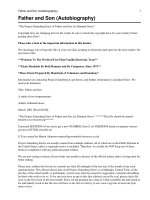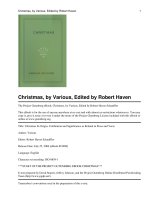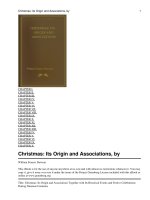Father Christmas
Bạn đang xem bản rút gọn của tài liệu. Xem và tải ngay bản đầy đủ của tài liệu tại đây (41.1 KB, 3 trang )
I INTRODUCTION
Santa Claus, legendary bringer of gifts at Christmas. He is generally depicted (described) as a fat,
jolly man with a white beard, dressed in a red suit trimmed with white, and driving a sleigh (xe
trượt tuyết) full of toys drawn (kéo) through the air by eight reindeer (con tuần lộc). Santa (also
called Saint Nicholas and Saint Nick) is said to visit on Christmas Eve, entering houses through
the chimney to leave presents under the Christmas tree and in the stockings of all good children.
Although this familiar image of Santa Claus is a North American invention of the 19th century, it
has ancient European roots and continues to influence the celebration of Christmas throughout the
world.
II ORIGINS OF THE LEGEND
Sinter Klaas The Dutch Saint Nicholas, or Sinter
Klaas, is the immediate forebear (tổ tiên) of the
North American Santa Claus. According to
legend, Sinter Klaas makes his rounds on
December 5, Saint Nicholas's Eve. He is
sometimes said to be accompanied by a figure
named Black Peter, who carries a whip (roi da,
người đánh xe ngựa) with which to chastize
naughty (nghòch ngỡm, không vâng lời, thô tục)
children. Here, dressed in a bishop's robes, Sinter
Klaas rides through the streets distributing (phân
phối) sweets to the children.THE BETTMANN ARCHIVE
The historical Saint Nicholas was venerated (vái lạy, sùng kính) in early Christian legend for
saving storm-tossed sailors, defending young children, and giving generous gifts to the poor.
Although many of the stories about Saint Nicholas are of doubtful (nghi ngờ, hồ nghi) authenticity
(tính xác thực, (for example, he is said to have delivered a bag of gold to a poor family by tossing
it through a window)), his legend spread throughout Europe, emphasizing his role as a traditional
bringer of gifts. The Christian figure of Saint Nicholas replaced or incorporated various pagan
gift-giving figures such as the Roman Befana and the Germanic Berchta and Knecht Ruprecht.
The saint was called Sankt Nikolaus in Germany and Sanct Herr Nicholaas or Sinter Klaas in
Holland. In these countries Nicholas was sometimes said to ride through the sky on a horse. He
was depicted wearing a bishop's robes and was said to be accompanied at times by Black Peter, an
elf whose job was to whip the naughty children.
The feast (ngày hội) day of Nicholas, when presents were received, was traditionally observed
(cử hành, tuân theo) on December 6. After the Reformation, German Protestants encouraged
veneration (sự sùng kính/tôn kính) of the Christkindl (Christ child) as a gift giver on his own feast
day, December 25. When the Nicholas tradition prevailed (thắng thế, thuyết phục), it became
attached (gắn bó) to Christmas itself. Because the saint's life is so unreliably (không chắn chắn)
documented (chứng minh bằng tài liệu), Pope Paul VI ordered the feast of Saint Nicholas dropped
from the official Roman Catholic calendar in 1969. The term Christkindl evolved (mở ra, suy ra)
to Kriss Kringle, another nickname for Santa Claus. Various other European Christmas gift givers
were more or less similar to Saint Nicholas: Père Nl in France, Julenisse in Scandinavia, and
Father Christmas in England.
III AMERICAN ORIGINS
The American version of the Santa Claus figure received its inspiration (sự kích thích trí tuệ, cảm
nghó) and its name from the Dutch legend of Sinter Klaas, brought by settlers (người khai hoang,
người giải quyết vấn đề) to New York in the 17th century. As early as 1773 the name appeared in
the American press as “St. A Claus,” but it was the popular author Washington Irving who gave
Americans their first detailed information about the Dutch version of Saint Nicholas. In his History
of New York, published in 1809 under the pseudonym Diedrich Knickerbocker, Irving described
the arrival of the saint on horseback (unaccompanied by Black Peter) each Eve of Saint Nicholas.
This Dutch-American Saint Nick achieved his fully Americanized form in 1823 in the poem A
Visit From Saint Nicholas—more commonly known as The Night Before Christmas—by writer
Clement Clarke Moore. Moore included such details as the names of the reindeer; Santa Claus's
laughs, winks, and nods; and the method by which Saint Nicholas, referred to as an elf, returns up
the chimney. (Moore's phrase “lays (trình bày, bài thơ) his finger aside (về một bên, để dành,
ngẫu nhiên) of his nose” was drawn directly from Irving's 1809 description.)
The American image of Santa Claus was further elaborated (tỷ mỉ, kỹ lượng) by illustrator (người
vẽ tranh minh họa) Thomas Nast, who depicted a rotund (mập mạp) Santa for Christmas issues of
Harper's magazine from the 1860s to the 1880s. Nast added such details as Santa's workshop at
the North Pole and Santa's list of the good and bad children of the world. A human-sized version
of Santa Claus, rather than the elf of Moore's poem, was depicted in a series of illustrations for
Coca-Cola advertisements introduced in 1931. In modern versions of the Santa Claus legend, only
his toy-shop workers are elves. Rudolph, the ninth reindeer, with a red and shiny nose, was
invented in 1939 by an advertising writer for the Montgomery Ward Company.
IV MODERN INFLUENCES
Santa Claus Traditionally, Saint Nicholas was depicted as a tall, dignified ecclesiastical (thuộc
giáo hội) figure riding a white horse. The distinctive iconography of the North American Santa
Claus—a chubby (mập mạp), bespectacled (đeo kính) elf dressed in red—took shape over the
course of the 19th century. The popular image of Santa Claus, shown here, developed from
literary descriptions by novelist Washington Irving and poet Clement Clarke Moore and the
fanciful (thích kỳ lạ) drawings of illustrator Thomas Nast.FPG International, LLC/Paul Markow
The fully detailed modern image of Santa Claus plays a part in Christmas celebrations around the
world. People are reminded of Santa Claus through advertising, greeting cards, decorations, and
the annual (hàng năm) appearance of Santas in department stores and shopping malls (in some
cases accompanied by Mrs. Claus and Santa's elves). The figure of Santa Claus occurs in motion
pictures—for example, Miracle on 34th Street (1947)—and in songs such as “Santa Claus Is
Coming to Town,” (1932) and “Here Comes Santa Claus,” (1947). Children write letters to Santa
Claus and set out milk and cookies on Christmas Eve as a snack (bữa ăn qua loa/nhẹ nhàng) for
Santa.
Although most adults view Santa as the embodiment (người hoặc vật là hiện thân của cái gì) of a
spirit of giving, some argue (tranh luận) that the modern image of Santa Claus conflicts with the
true meaning of Christmas and promotes greed and commercialism. To reconcile the legend of
Santa Claus with the religious significance of Christmas, some Christians emphasize that the
modern figure is derived (xuất phát) from legends about a saint who symbolized (biểu tượng)
love, caring (chu đáo), and generosity (sự rộng lượng).


